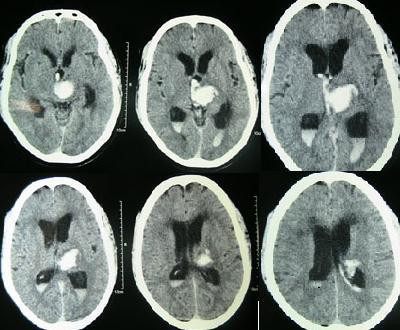- Intraventricular hemorrhage
Infobox_Disease
Name = Intraventricular hemorrhage

Caption = CT scan showing spontaneous intracerebral hemorrhage with bleeding in the third and both lateral ventricles andhydrocephalus cite journal |author=Yadav YR, Mukerji G, Shenoy R, Basoor A, Jain G, Nelson A |title=Endoscopic management of hypertensive intraventricular haemorrhage with obstructive hydrocephalus |journal=BMC Neurol |volume=7 |issue= |pages=1 |year=2007 |pmid=17204141 |pmc=1780056 |doi=10.1186/1471-2377-7-1 |url=http://www.biomedcentral.com/1471-2377/7/1]
DiseasesDB = 6906
ICD10 = ICD10|I|61|5|i|60
ICD9 = ICD9|431
ICDO =
OMIM =
MedlinePlus =
eMedicineSubj = ped
eMedicineTopic = 2595
MeshID =
An intraventricular hemorrhage (or "IVH") is a bleeding of the brain'sventricular system , where thecerebrospinal fluid is produced and circulates through towards thesubarachnoid space . It can result fromphysical trauma or from hemorrhaging instroke .In infants
This type of hemorrhage is particularly common in infants, especially
premature infants or those of very low birth weight.Annibale DJ and Hill J. 2006. [http://www.emedicine.com/ped/topic2595.htm Periventricular Hemorrhage-Intraventricular Hemorrhage] . Emedicine.com. Retrieved onJune 19 ,2007 .] The cause of IVH in premature infants, unlike that in older infants, children or adults, is rarely due to trauma. Instead it is thought to result from changes in perfusion of the delicate cellular structures that are present in the growing brain. The lack of blood flow results in cell death and subsequent breakdown of the blood vessel walls, leading to bleeding. While this bleeding can result in further injury, it is itself a marker for injury that has already occurred. Most intraventricular hemorrhages occur in the first 72 hours after birth.In adults
Intraventricular hemorrhage is rare in adultsMayfrank L, Kissler J, Raoofi R, Delsing P, Weis J, Kuker W, and Gilsbach JM. 1997. [http://stroke.ahajournals.org/cgi/content/full/28/1/141 Ventricular Dilatation in Experimental Intraventricular Hemorrhage in Pigs: Characterization of Cerebrospinal Fluid Dynamics and the Effects of Fibrinolytic Treatment] . "Stroke", 28:141–148. Retrieved on
June 19 ,2007 .] and requires a great deal of force to cause. Thus the hemorrhage usually does not occur without extensive associated damage, and so the outcome is rarely good.Dawodu S. 2007. [http://www.emedicine.com/pmr/topic212.htm "Traumatic Brain Injury: Definition, Epidemiology, Pathophysiology"] Emedicine.com. Retrieved onJune 19 ,2007 .] Vinas FC and Pilitsis J. 2006. [http://www.emedicine.com/med/topic2888.htm "Penetrating Head Trauma."] Emedicine.com.]Prognosis is also dismal when IVH results from
intracerebral hemorrhage related to high blood pressure and is even worse whenhydrocephalus follows. It can result in dangerous increases inintracranial pressure and can cause potentially fatalbrain herniation .Associated conditions
Brain contusion s andsubarachnoid hemorrhage s are commonly associated with IVH.LeRoux PD, Haglund MM, Newell DW, Grady MS, and Winn HR. 1992. [http://www.ncbi.nlm.nih.gov/entrez/query.fcgi?cmd=Retrieve&db=PubMed&list_uids=1407453&dopt=Abstract "Intraventricular hemorrhage in blunt head trauma: an analysis of 43 cases."] "Neurosurgery". Volume 4, pp. 678-84. PMID 1407453. Retrieved onJune 19 ,2007 .] The bleeding can involve themiddle communicating artery or theposterior communicating artery .In both adults and infants, IVH can cause dangerous increases in
intracranial pressure , damage to the brain tissue, andhydrocephalus .References
External links
*
Wikimedia Foundation. 2010.
